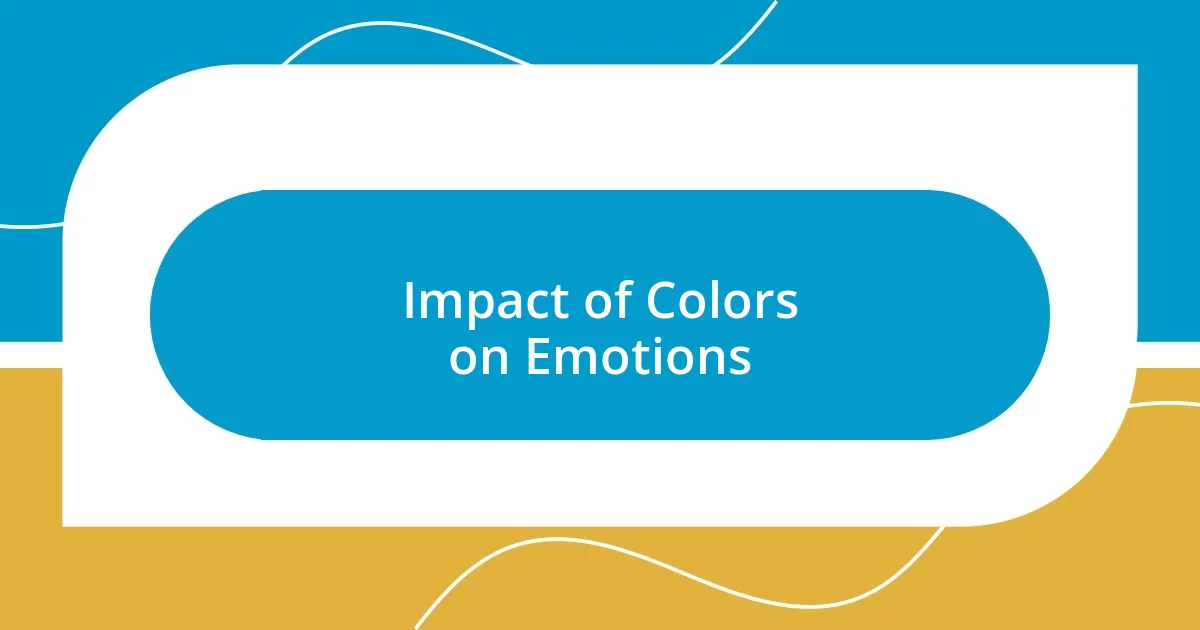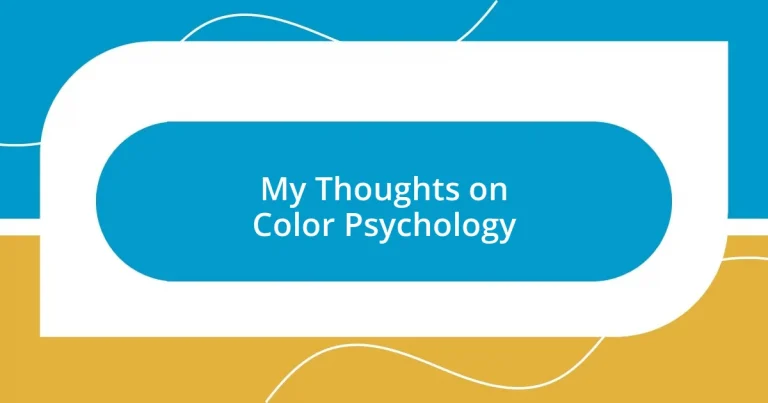Key takeaways:
- Color psychology significantly influences emotions and behaviors, with colors like red evoking urgency and blue promoting calmness.
- In branding, colors shape consumer perceptions; for instance, blue symbolizes trust, while warm colors like red and yellow create excitement.
- The choice of colors in personal spaces can enhance mood and productivity, highlighting the importance of intentional color selection.
- Testing colors in different lighting and considering their interaction with existing decor is crucial for effective design.

Understanding Color Psychology Basics
Color psychology delves into how colors influence human emotions and behaviors, creating a fascinating interplay between perception and experience. For instance, I’ve noticed that being in a bright yellow room instantly lifts my spirits, making me feel more energetic and optimistic. Isn’t it intriguing how a simple color can change our mood so profoundly?
Reflecting on my personal encounters, I remember an old friend who painted her office walls blue, claiming it helped her focus better. I was skeptical at first, but every time I visited, the calming effect was undeniable. It made me wonder—could colors in our environment subtly affect our productivity and creativity more than we realize?
Understanding the basics starts with recognizing that every color carries its own emotional weight. For instance, red often evokes passion or urgency, while green connects us to nature and tranquility. Curiously, have you ever caught yourself gravitating toward a particular color during different seasons or moods? It’s these subtle shifts that can reveal much about our inner states and how we relate to the world around us.

Significance of Color in Branding
The significance of color in branding goes far beyond mere aesthetics; it plays a critical role in shaping consumer perceptions and influencing purchasing decisions. I’ve experienced firsthand the power colors can have on how a brand resonates with me. For example, when I see a bright orange logo, it instantly feels more approachable and fun, almost like an invitation to explore. On the other hand, a sleek black design tends to exude sophistication, often making luxury brands more appealing.
- Colors can evoke specific emotions and associations that brands leverage.
- For instance, blue often signifies trust and reliability, which is why many financial institutions adopt it.
- Warm colors like red and yellow can create excitement and urgency, ideal for fast-food chains.
- Green is frequently used for environmentally conscious brands, aligning with themes of sustainability.
I’ve also noticed how certain brands become instantly recognizable just by their color alone—think of Coca-Cola’s vibrant red or Tiffany & Co.’s signature robin’s egg blue. These colors not only help establish a brand’s identity but also create a lasting bond with customers, inviting them into a familiar emotional landscape every time they encounter the brand.

Impact of Colors on Emotions
Colors indeed have a profound impact on our emotions. When I walk into a room with soft, pastel colors, I can’t help but feel more relaxed, almost like I’m enveloped in a cozy embrace. It’s fascinating how the gentle hues can create a sense of calm, while harsher colors, such as a bright red, can stimulate not just alertness but also feelings of excitement or anxiety. Have you ever noticed how certain colors seem to amplify your mood in unexpected ways?
I remember attending an art exhibit that showcased various color palettes, each aimed to evoke different feelings. One piece dominated the room with deep blues and greens, inviting serenity and reflection. In contrast, another piece flooded the space with fiery oranges and reds, igniting a burst of energy that felt almost infectious. This experience reinforced my understanding of how color not only decorates our spaces but also shapes our emotional landscapes and can even foster connection with those around us.
Further highlighting this concept is the idea that our emotional responses to colors can vary based on culture and context. For instance, while white symbolizes purity in many Western cultures, it can represent mourning in some Eastern traditions. This cultural aspect adds another layer to our emotional reactions, showing that the impact of colors is not just personal but also collective.
| Color | Emotional Impact |
|---|---|
| Red | Passion, urgency, energy |
| Blue | Calmness, trust, focus |
| Yellow | Happiness, optimism, warmth |
| Green | Tranquility, nature, balance |
| Orange | Enthusiasm, creativity, warmth |

Choosing Colors for Marketing
Choosing colors for marketing is a fascinating endeavor that involves much more than simply picking what looks nice. When I worked on a campaign for a wellness brand, we opted for a soft green palette. The goal was to evoke feelings of tranquility and trust, perfectly aligning with the brand’s message. Seeing the positive feedback from the audience reinforced my belief in how powerful the right color can be in enhancing a brand’s ethos.
Have you ever stopped to think about how certain colors can shift your perception of a product? I remember browsing a website for a new tech gadget that featured a sleek, dark blue theme. The color made me feel like the product was cutting-edge and reliable, even before I read the specs. It’s intriguing how certain hues can unintentionally communicate quality and innovation, shaping our buying decisions before we even engage with the details.
Looking back, I’m always amazed at how a quick glance at a color can trigger an emotional response that nudges us toward a purchase. While working on an ad for a local café, we used bright yellows and warm reds. The colors generated an inviting warmth, creating an instant sense of comfort that made customers want to step inside. Can you remember a time when a color made you feel drawn to a brand or product? Those moments illustrate how effectively color can work in marketing, crafting an emotional connection that draws customers in.

Using Color in Personal Spaces
Have you ever considered how the colors in your personal space can truly reflect and affect your mood? I once painted my home office a soothing soft blue, and the moment I stepped inside, I felt a wave of calm wash over me. It’s incredible how the right shade can create a sanctuary where I can think clearly and feel inspired.
In another instance, I decided to use vibrant yellow accents in my kitchen. Every time I walked into that space, the cheerful hue sparked joy and positivity, especially during those hectic mornings. It made such a difference in my daily routine, reminding me that a simple splash of color can turn an ordinary moment into something uplifting.
I often find myself drawn to deep greens when decorating my living room. These hues remind me of nature, allowing me to feel more grounded and connected. This experience makes me wonder: how can we intentionally use color to curate our surroundings and emotional experiences? By thoughtfully choosing the colors in our personal spaces, we can create environments that resonate with our feelings and aspirations, transforming them into reflections of who we are.

Color Schemes for Different Moods
When it comes to different moods, the color red often stands out for its boldness and energy. I threw a dinner party adorned with rich red table settings, which instantly ignited excitement and liveliness among my guests. It’s fascinating how that one color choice transformed the room’s atmosphere and fostered a sense of passion and vigor.
On a quieter note, I’ve embraced shades of lavender in my bedroom to cultivate an environment of serenity and introspection. Whenever I enter that space, I can’t help but feel a sense of calm wash over me, as if the color has wrapped me in a gentle embrace. Have you noticed how certain colors can create a peaceful retreat in our busy lives?
In my experience, I’ve found that deep blue tones evoke a sense of trust and reliability, making them ideal for spaces where focus and productivity are key. For instance, my friend painted her study a deep navy, which created a conducive environment for concentrating on her work. How have your color choices influenced your own productivity or mood? It’s worth contemplating how we can wield color as a tool to enhance our emotional wellbeing and personal spaces.

Practical Tips for Color Selection
When selecting colors, it’s important to consider how they make you feel. I remember walking into a friend’s salon painted in a warm coral shade, and immediately feeling uplifted. That welcoming vibe made me realize: if a color can induce such a reaction in one setting, it can do the same in my personal spaces. So, as you contemplate your color palette, ask yourself: what emotions do I want to evoke here?
Another practical tip I’ve learned is to test colors in different lighting. I once painted my hallway a vibrant orange, convinced it would bring warmth. However, under the harsh fluorescent light, it looked overly energetic and almost overwhelming. A better approach would have been to try swatches in various light conditions before committing. Have you ever painted a room only to realize that the color isn’t what you expected?
Finally, consider the bigger picture – how your chosen colors will interact with the other elements in your space. When I recently decorated my bedroom, I paired a cool mint green with soft gray accents. The combination created a soothing atmosphere, allowing the colors to play off each other beautifully. Have you thought about how your colors can either clash or harmonize with your existing décor? Sometimes, the right blend can elevate a room beyond what you imagined.














